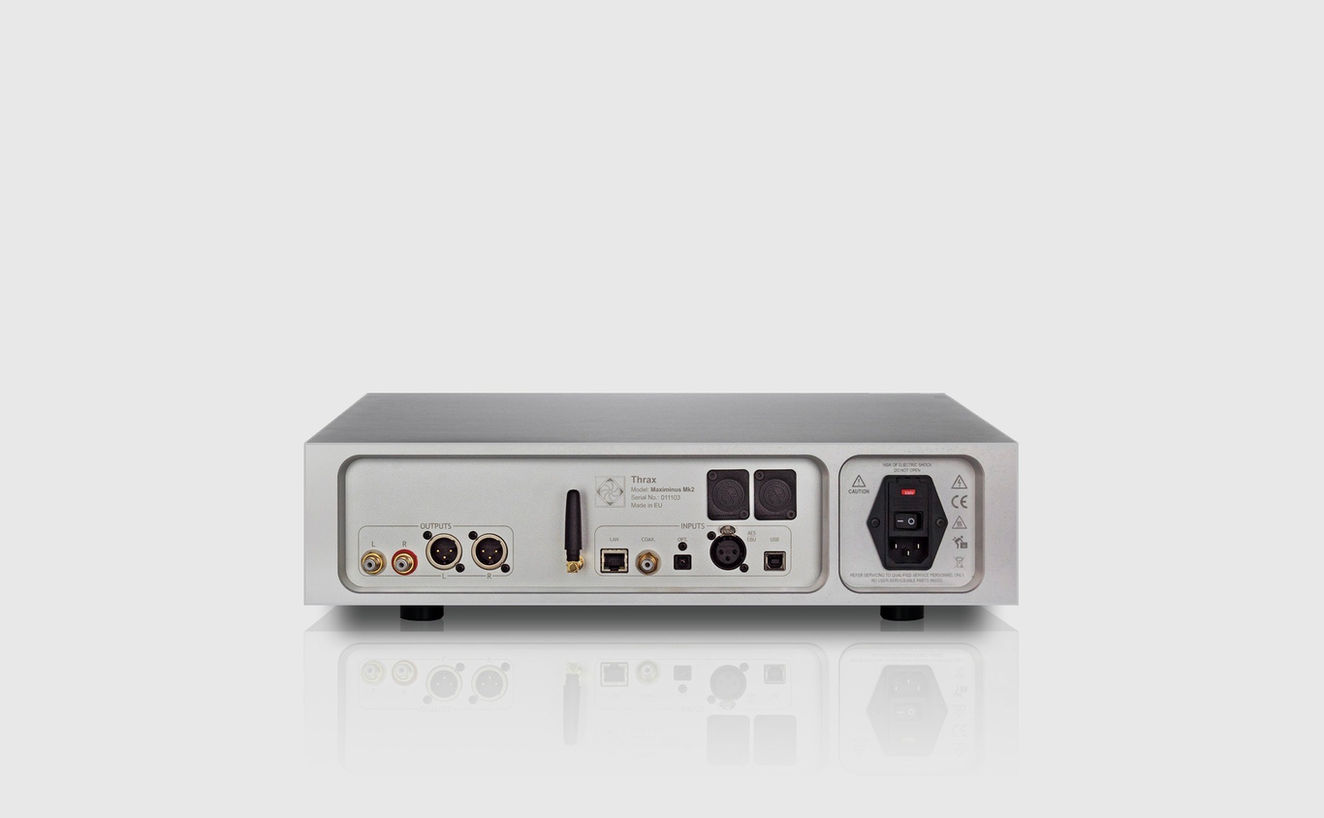STREAMING AUDIO DAC
MAXIMINUS MK2S


Maximinus DAC: The Emperor of Digital Audio
-
R2R ladder multibit conversion with 1ppm precision for unparalleled analog-like sound.
-
Fully differential operation with 40Vp-p output for maximum signal integrity.
-
No I/V conversion or reconstruction filtering—just pure, transformer-coupled output.
-
Advanced digital processing with upsampling and user-controllable filtering.
-
Ultra-low phase noise clocks and jitter-removing re-clocking for pristine timing.
-
Total galvanic isolation and transformer/optical decoupling for noise-free performance.
-
Modular design for future upgrades and upgradable firmware.
-
Sealed solid aluminum enclosure for vibration damping and EMI/RFI shielding.
-
6 inputs, DSD support, and Roon Ready streaming compatibility.
The Maximinus DAC
is a masterpiece of digital-to-analog conversion, designed to redefine what’s possible in high-end audio. Combining groundbreaking technology with meticulous craftsmanship, Maximinus delivers a listening experience that is as truthful as it is transformative. Whether you’re a purist seeking the ultimate in analog-like sound or a modern audiophile embracing the latest in digital innovation, Maximinus stands as a testament to uncompromising performance.
The R2R Ladder: A Return to Truth
At the heart of Maximinus lies the R2R ladder—a resistor matrix that switches to deliver precise output levels, much like a volume control. This multibit conversion approach, combined with our in-house developed 1ppm precision conversion module, brings digital audio to new heights.

The result is analog tone and transparency that surpasses even the legendary NOS Philips and Burr Brown DACs, as well as modern delta-sigma converters.
Maximinus doesn’t just reproduce music—it reveals it. With its ultra-fast switching logic and unparalleled precision, it strips away the veil of digital artifacts, presenting the “naked truth” of your music. (And yes, sometimes the truth isn’t pretty—but it’s always breathtaking.)
Full Differential Operation for Purity
Maximinus operates in a fully differential manner, ensuring maximum signal integrity and noise rejection. With a 40Vp-p output, it guarantees the highest signal-to-noise ratio, delivering a soundstage that is both expansive and precise.
No Compromises: No I/V Conversion, No Filtering
Unlike conventional DACs, Maximinus eliminates the need for I/V conversion and reconstruction filtering. Instead, the output signal is passed through a silver line-level output transformer, which scales the output to industry standards while further reducing noise. This approach ensures the cleanest possible signal with zero feedback, preserving the natural character of your music.
Advanced Digital Processing
Maximinus features a suite of advanced algorithms for digital filtering and upsampling. For example, it can convert 16-bit/44.1kHz CD data to 32-bit/352.8kHz, greatly improving low-level resolution and spatial detail. This process averages DAC error over 8 cycles, akin to having 8 DACs in parallel.
But for purists, Maximinus offers complete control. You can bypass all processing for non-oversampling (NOS) playback, ensuring that your music remains untouched by digital manipulation.
Jitter-Free Performance
Clock phase noise is critical to sound quality, and Maximinus spares no effort in this regard. It features ultra-low phase noise clock generators and jitter-removing re-clocking logic, ensuring that every conversion is timed with absolute precision. Multi-bit DACs are inherently less sensitive to jitter, and Maximinus takes full advantage of this, revealing layers of detail that rival—and often surpass—analog playback.
Galvanic Isolation and Noise Rejection
Maximinus is designed to eliminate external interference. All inputs are transformer or optically decoupled, preventing contaminated ground connections and other noise from affecting the signal. Combined with total galvanic isolation of internal circuits, this ensures that your music remains pure and undisturbed.
Modular Design for Future-Proof Performance
Maximinus is built to evolve. Its modular design allows for field upgrades, ensuring that it remains at the cutting edge of digital audio technology. With upgradable firmware and support for the latest streaming protocols, Maximinus is a DAC that grows with you.
Sealed Solid Aluminum Enclosure
Housed in a sealed solid aluminum chassis, Maximinus is designed to shield its delicate internals from vibration, EMI, and RFI. This construction follows the same principles as our preamplifiers, ensuring a noise-free environment for the DAC’s critical components.
Streaming and Connectivity
Maximinus is more than just a DAC—it’s a complete digital audio solution. It features 6 inputs, including balanced XLR and unbalanced RCA outputs, and supports DSD playback. As a Roon Ready device, it seamlessly integrates into your digital ecosystem, offering support for multiple streaming protocols.
Available Finishes

BLACK ANODIZED ALUMINUM

SILVER ANODIZED ALUMINUM
Product History
Introduced in 2012 - the Maximinus was based around an MSB Diamond DAC motherboard reworked to use our shunt regulation power supplies and modules with bypassed output stages connected to a custom transformer made for us.
In 2015 we replaced the MSB modules with our own development further improving low-level eligibility and dynamics while still retaining the MSB motherboard as the core. There is no functional or cosmetic difference among the units.
In 2019 the Maximinus Mk2 was launched replacing the aging MSB with our own input board handling all digital processing and adding multi-format streaming capabilities while the development of our integrated converter board with local oscillators went a step further toward perfection and unmatched sonics. The Mk2 is recognizable by the feature of a color LCD display replacing the green dot matrix and a different back panel design. The "S" adds silver output transformer







